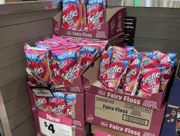Crushing new reality for Australian Families as grocery bills soar
- Replies 8
We can tell you a horror story in just one sentence… Food prices are skyrocketing (someone cue the blood-curdling screams!). It seems as though everything nowadays is doubling or tripling in value. Petrol prices, as we all know, devastatingly soared up which in turn encouraged more people to turn to alternatives like riding a bike.
But jumping on the list are groceries and unless you’re growing your own produce or you’re a billionaire, then there aren’t that many workarounds left for the rest of us.
Image Credit: ABC
The rising cost eerily hovers over the shoulders of those who are on the pension who may be living alone or with a partner, who are already struggling to make ends meet, as well as big Australian families who have multiple mouths to feed and even the slightest of price increases adds up.
One bloke couldn’t help but notice the difference when he went on a grocery run with his family. Ben Graham was initially pleased to see some staples like fresh berries and avocados being reasonably priced (two punnets of berries for $7 and $1.20 each avocado), but he knew that he was in for a surprise considering how supermarkets tend to lure people in with good bargains to brace them for an impending, sky-high price hike.
Snow peas retailing at $22 per kilogram. The horror! Image Credit: news.com.au
“It says a lot about how fast prices have risen that we weren’t surprised to see capsicums being flogged for an eye-watering $14.90/kg (and that was allegedly on special) and snow peas going for a ludicrous price of $22/kg as if they contained tiny diamond nuggets inside.” he exclaimed.
The price of tomatoes has also risen to a mind-boggling amount – a true and living nightmare for Italians and tomato-based sauce lovers – a punnet of cherry tomatoes on the shelves nowadays may retail for up to $7.70, which to us, is just staggering.
Bananas also rose from under $2 to $3 per kilogram, which isn’t as bad in comparison to other types of produce, but it may still leave you wanting to consider ditching banana snacks like banana bread for the time being. To add to that, eggs slightly rose to $4.50 from $4 a dozen.
Ben, who was keeping an eye out for price differences said: “The only really decent prices we found in the fresh produce were for carrots, at just $1.50 for a big bag — so if a nuclear war breaks out at least we can all live off those.”
Moving onto the meat, Ben shared that there was nothing too alarming but $10.50 for a pack of lean mince still seems quite steep. He believed sausages only seemed worth the value if bought in bulk and $12 for a pack of 24 was over the top. So, they got their hands on a pack of salmon instead that was still costly (priced at $16) but at least it’s healthy and sustainably sourced.
Since Ben has a little one, they had to stop by the nappies and wipes aisle too. Thinking they would be met with a heart-stopping price hike, they were pleased to discover that a big bag of nappies in their kid’s size only retails at $9, which to him seemed like a ‘gift from the heavens’.
An increase of a few dollars and a few cents here and there doesn’t seem all too bad, right? Well... not exactly.
“It appeared on the surface that the prices of almost everything else we bought from chips to kids snacks, sandwich fillers, bread, eggs and yoghurt were not too far away from what it was several months ago.” he said.
Ben’s shocking total. Image Credit: news.com.au
“However, the reality of the situation dawned on us shortly when my wife approached with the news of the damage… The receipt revealed that the jaunt around Coles cost us a whopping $364.04, which is one of our highest ever totals. That is without any toiletries or basic cupboard fillers that we already had at home.”
Ben later on hunted down their receipts from last year’s grocery runs and realised that their expenses used to only be around $200 to $250, leading to the conclusion that even the ‘unnoticeable’ price hikes do make a huge impact in the end.
“It appears although a lot is made of the big increases in prices of vegetables like $5.50 lettuces, I think we were taken aback by the little increases across a range of foodstuffs and everyday products that you would barely notice.”
The harsh reality is that the cost of living is rising at an alarming rate as a result of various factors such as the pandemic, freight costs, recent extreme weather, and the ongoing war between Russia and Ukraine – all of which play a vital role in creating short and long-term supply issues, which in turn causes food and global oil prices to soar.
“Food and grain prices are rising, which will pose challenges to lower-income economies, including many in our own region,” Prime Minister Scott Morrison told the AFR Business Summit earlier this month in a speech.
“Commodity price rises will be the most obvious transmission channel to Australia. Petrol prices in Australia have risen, like they are elsewhere.”
Ritchies IGA chief executive Fred Harrison warned last week that families could expect to pay more for fresh and frozen food in the coming weeks thanks to the combined impact of the war in Ukraine and the recent floods in NSW and Queensland.
“Vegetables are very scarce at the moment due to the floods,” Mr Harrison told the ABC. “So we’ve seen cabbages, potatoes and broccoli in particular jump 75 per cent compared to a couple of weeks ago.”
Brace yourselves, folks. We’re holding onto our seats for what’s to come in future trips to the grocery.
Want to catch a glimpse of some brief news coverage of the issue? Watch the video below!
Video Credit: 7NEWS Australia







